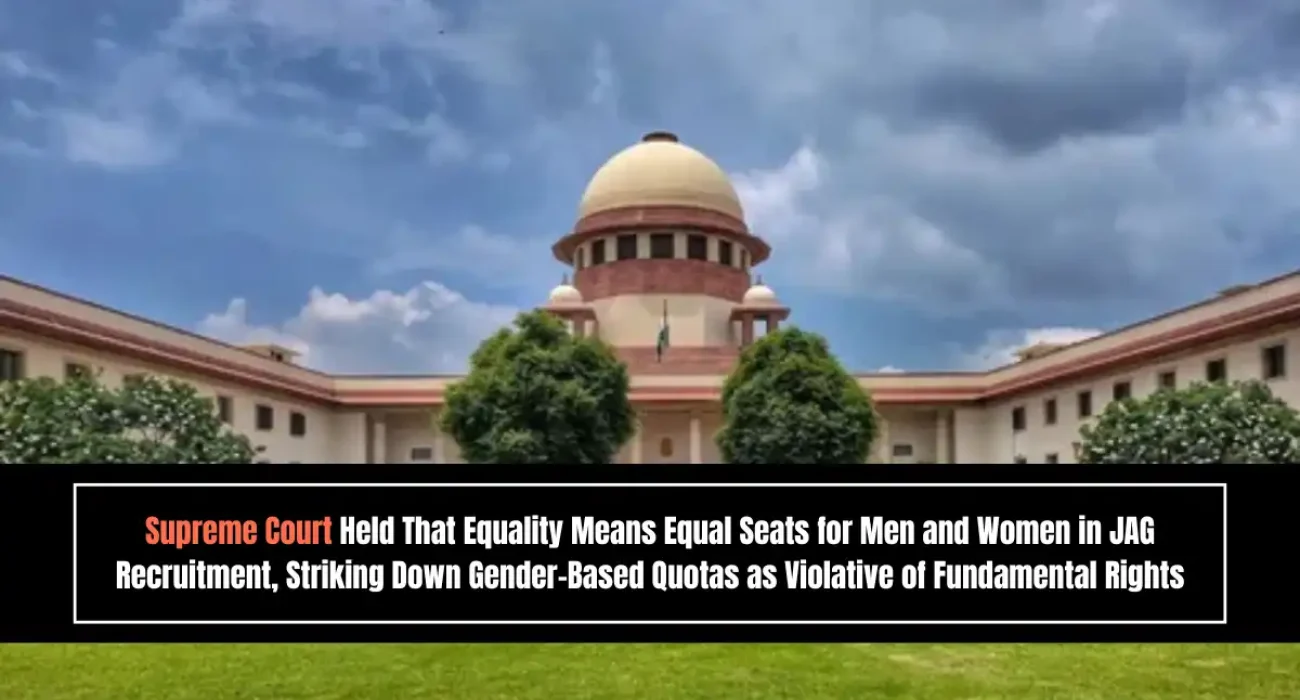

Table of Contents
ToggleThe petition was filed challenging the Indian Army’s policy restricting the intake of women officers into the Judge Advocate General (JAG) branch through a fixed ratio, earlier 70:30 in favour of men and from 2024 at 50:50. Petitioner No.1, Ms. A, contended that such restrictions were discriminatory and violated Articles 14, 15, and 16 of the Constitution. Petitioner No.2, Ms. B, was also initially part of the case but later joined the Indian Navy JAG-SSC and withdrew her claim. The central question before the Court was whether, after issuing notifications under Section 12 of the Army Act, 1950 allowing women to join the JAG branch, the Army could still limit their numbers through administrative policies. The case also examined whether gender-based operational restrictions such as non-deployment of women in certain postings had legal validity.
The petitioners argued that once the Central Government had issued notifications under Section 12 of the Army Act permitting women to serve in the JAG branch, any further restriction on their numbers through policy or administrative instructions was unconstitutional. They contended that the Army’s reliance on internal instructions of 2011 and 2012, citing operational readiness and possible combat deployment, was misplaced, outdated, and based on gender stereotypes. Petitioners cited examples of women excelling in challenging operational environments, including Lt. Col. Jyoti Sharma’s foreign mission, Major Radhika Sen’s UN award, and women officers serving in high-risk areas like Siachen Glacier and Army Aviation Corps. They emphasised that merit, not gender, should determine selection, and that using the possibility of combat as a reason to restrict non-combat postings for women was an illogical extension that could bar women from multiple roles in the armed forces. They argued that the so-called “evolving process” of gender integration was a regressive step if the intake ratio continued to limit women’s entry.
The Union of India, represented by the Additional Solicitor General, argued that gender integration in the defence services is a calibrated and evolving process, aligned with operational needs, cadre health, and deployment constraints. They emphasised that men and women are assessed separately and that a common merit list was not feasible. Relying on Article 33 of the Constitution and Section 12 of the Army Act, they submitted that Parliament had the power to modify Fundamental Rights for the armed forces and that the Government could impose intake restrictions even within permitted branches. They referred to the 2012 policy which kept women out of certain deployments due to combat-related concerns and argued that such decisions fell within the executive’s exclusive domain of military readiness and command control. They maintained that JAG officers were combatants in reserve and could be deployed in operational conditions, thereby justifying intake limitations.
The Supreme Court emphasised that Articles 14, 15, and 16 of the Indian Constitution guarantee equality, and while Article 33 enables Parliament to restrict these rights for armed forces personnel, such restrictions must be explicitly provided by law. It held that after issuing a statutory notification under Section 12 of the Army Act, 1950 permitting women to serve in the JAG branch, the executive cannot impose additional numerical limits unless expressly authorised by Parliament. Such intake quotas like the 70:30 and 50:50 gender ratios lacked statutory backing, rendering them constitutionally untenable.
The Court also rejected reliance on internal policies of 2011 and 2012, describing them as archaic and based on gender stereotypes. It referred to the Babita Puniya judgment, which condemned such stereotypes as constitutionally flawed and discriminatory. Importantly, the Court dispelled the Army’s claim that JAG officers are primarily combatants, noting that JAG is a Combat Support Arm, not a Combat Arm, and that thus operational assumptions about potential deployment could not justify intake restrictions. The Court also highlighted that field parity had been institutionalised through updated policies granting identical operational exposure to women JAG officers.
Most notably, Justice Manmohan observed that “If ten women surpass all other candidates in merit, all ten must be inducted.”
The Supreme Court held that restricting women’s induction into the JAG branch through intake ratios beyond what is provided in Section 12 of the Army Act is unconstitutional. It declared that once women are permitted into a branch via statutory notification, the Army cannot limit their numbers by policy or administrative instructions. The Court directed that Petitioner No.1, Ms. A, be inducted into the next available JAG training course. It clarified that merit should be the sole criterion for selection, and women officers should be treated at par with men in all respects of recruitment and deployment within the permitted branches.
Written by Adv. Deeksha Rai
IAW resources
Browse our help directory